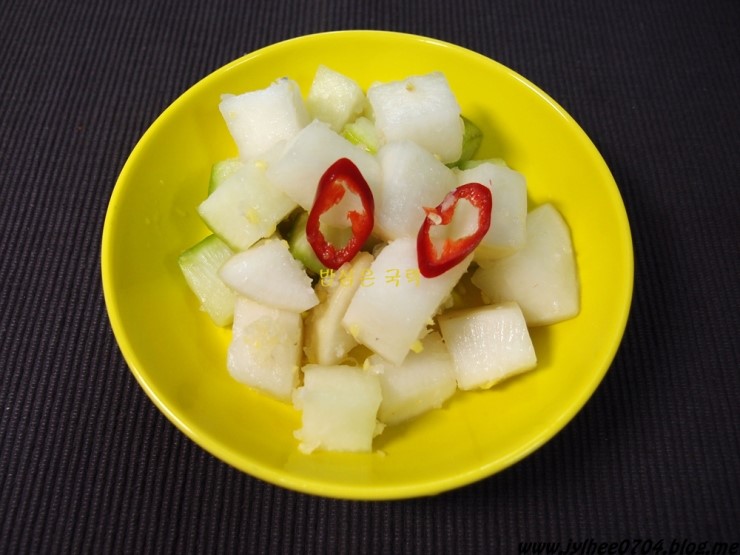
White radish kimchi
Radish is inexpensive and is used as the main ingredient of food or as an ingredient. It's an indispensable ingredient for kimchi. Sometimes it's crunchy raw, sometimes it's ripe and cool, and you can't give up on both. Radish has many effects, but it prevents obesity and is also effective as a cold medicine. When you see cold symptoms, make radish juice and drink a cup and sleep, and the cold energy disappears the next day as if it were washed away. It is good for smokers, but siniglin, a spicy ingredient of radish, stimulates the mucous membrane to activate the secretion of water-based mucus, which is effective for smokers who suffer from sputum caused by cigarettes because it dilutes phlegm and helps to spit it out easily. Also, it has excellent radish juice effect for people with allergic rhinitis. Raw food has an anti-inflammatory effect, so it cools the body and warms the body when it is boiled. Cooked radish is easy to digest. Today, we're going to make white radish kimchi. It's similar to regular kkakdugi without just adding pepper powder, but adding a small amount of salted fish can make it taste cleaner. Let's take a look.
6 serving
Within 999 minutes

밥심은국력
- Ingredients
-
-
Radish2ea
-
crushed garlic2TS
-
chopped ginger1TS
-
plum extract1TS
-
Sugar1TS
-
salted shrimp1TS
-
Red pepper1/2ea
-
a thick salt1ladle
-
Water5ladle
-
Sugar1.5TS
-
- Cooking Steps
-
STEP 1/12I used 2 small radishes
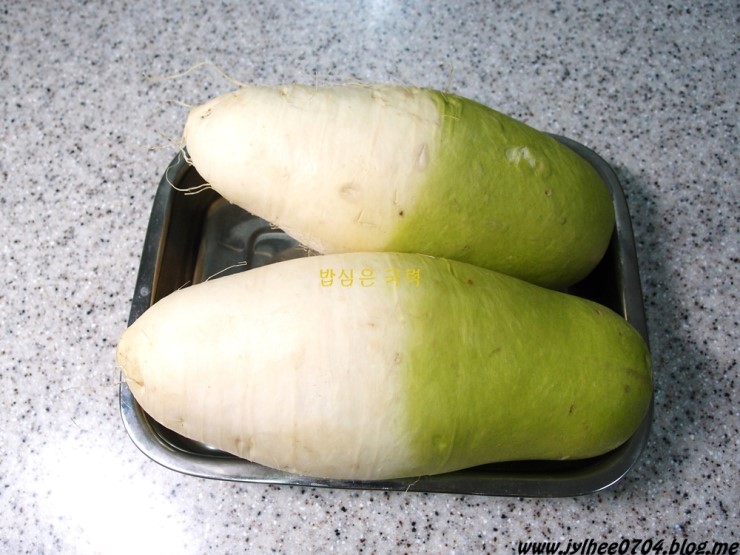 STEP 2/12Cut it into cubes, and after cutting it thickly, cut it into 3 to 4 pieces according to the diameter of the radish and cut it into squares.
STEP 2/12Cut it into cubes, and after cutting it thickly, cut it into 3 to 4 pieces according to the diameter of the radish and cut it into squares.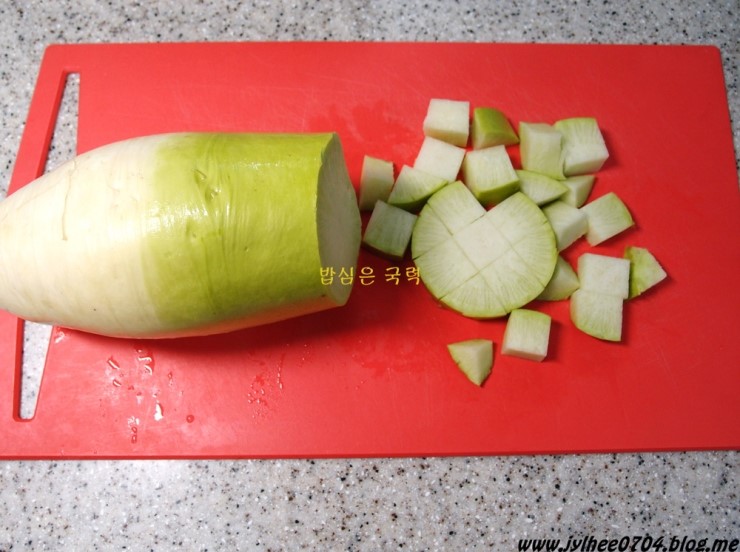 STEP 3/12I'm done cutting the cubes.
STEP 3/12I'm done cutting the cubes.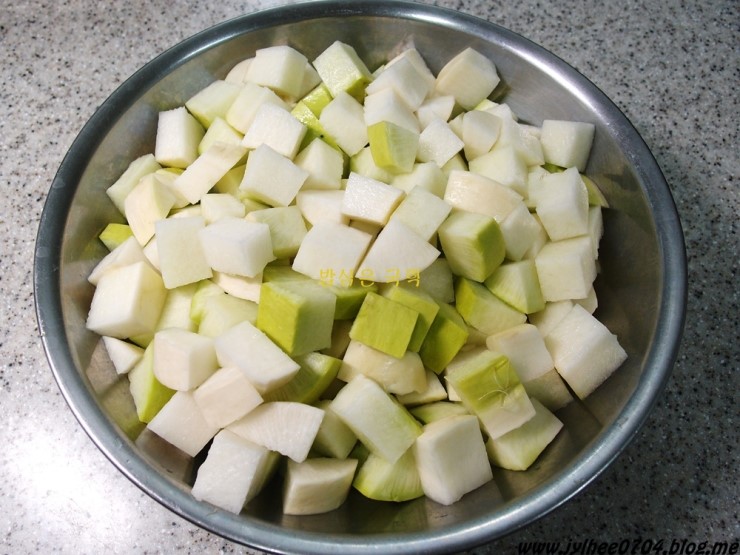 STEP 4/12You have to pickle the radish, and put 1 ladle of water and 1 tablespoon and a half of sugar in it using a large ladle with thick salt, and melt it evenly. Soaking with water is much better than just adding salt. If you add a little sugar, the radish tastes sweet, so it's much better when you make kkakdugi
STEP 4/12You have to pickle the radish, and put 1 ladle of water and 1 tablespoon and a half of sugar in it using a large ladle with thick salt, and melt it evenly. Soaking with water is much better than just adding salt. If you add a little sugar, the radish tastes sweet, so it's much better when you make kkakdugi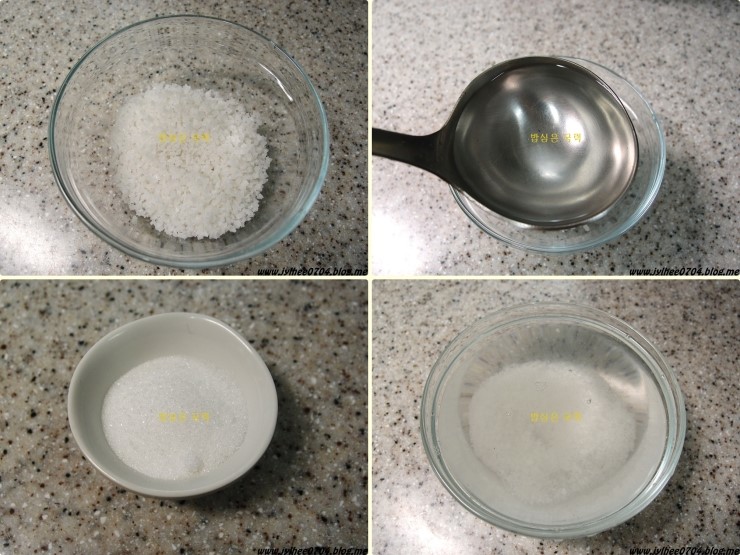 STEP 5/12Marinate for 2-3 hours. I marinated him for three hours. When salted, a lot of water escapes from the radish itself due to osmotic pressure. You can see a lot of water, right
STEP 5/12Marinate for 2-3 hours. I marinated him for three hours. When salted, a lot of water escapes from the radish itself due to osmotic pressure. You can see a lot of water, right STEP 6/12Rinse three times and drain for 30 minutes
STEP 6/12Rinse three times and drain for 30 minutes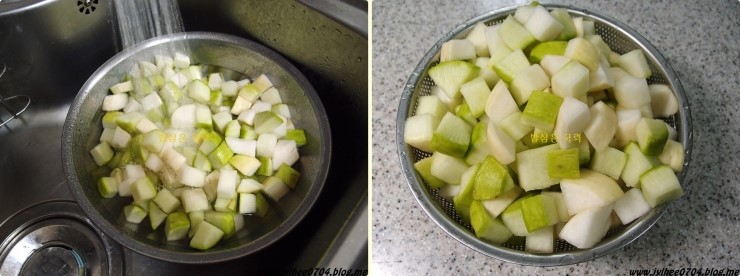 STEP 7/12The white radish kimchi seasoning is rather simple. Slice 2 tablespoons of minced garlic, 1 tablespoon of minced ginger, 1 tablespoon of minced shrimp, 1 tablespoon of sugar, 1 tablespoon of plum syrup, and half of red pepper diagonally. I like red pepper instead of red pepper
STEP 7/12The white radish kimchi seasoning is rather simple. Slice 2 tablespoons of minced garlic, 1 tablespoon of minced ginger, 1 tablespoon of minced shrimp, 1 tablespoon of sugar, 1 tablespoon of plum syrup, and half of red pepper diagonally. I like red pepper instead of red pepper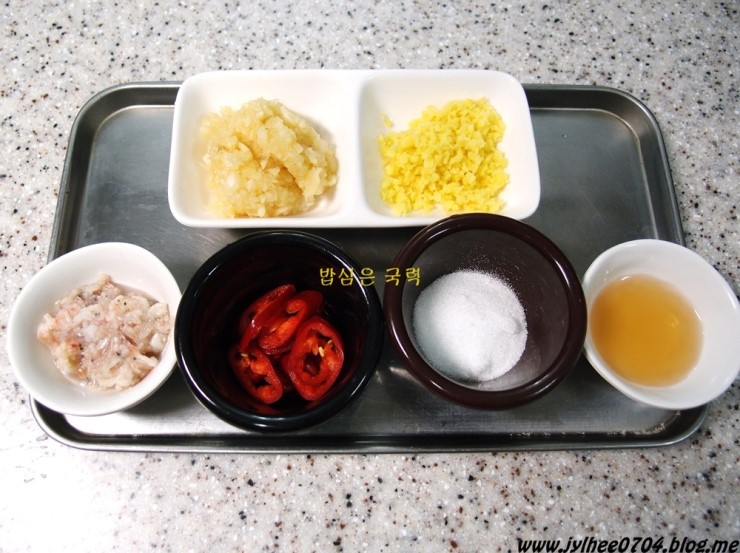 STEP 8/12Put the drained radish in a large bowl and mix it with all the seasoning except for the red pepper.
STEP 8/12Put the drained radish in a large bowl and mix it with all the seasoning except for the red pepper.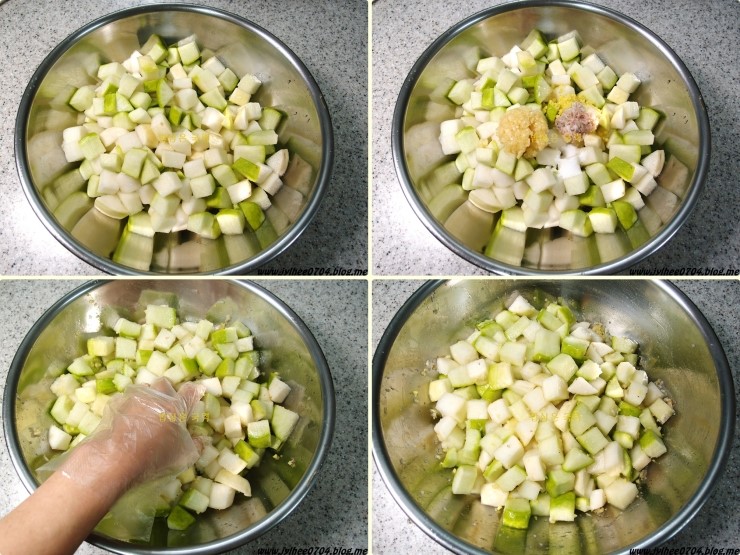 STEP 9/12Add red pepper at the end and mix it slightly. With red pepper, the color definitely stands out.
STEP 9/12Add red pepper at the end and mix it slightly. With red pepper, the color definitely stands out.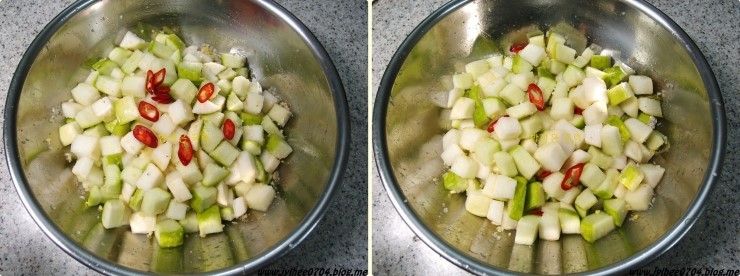 STEP 10/12Put it in the kimchi container, leave it at room temperature for a day, and then put it in the kimchi refrigerator.
STEP 10/12Put it in the kimchi container, leave it at room temperature for a day, and then put it in the kimchi refrigerator.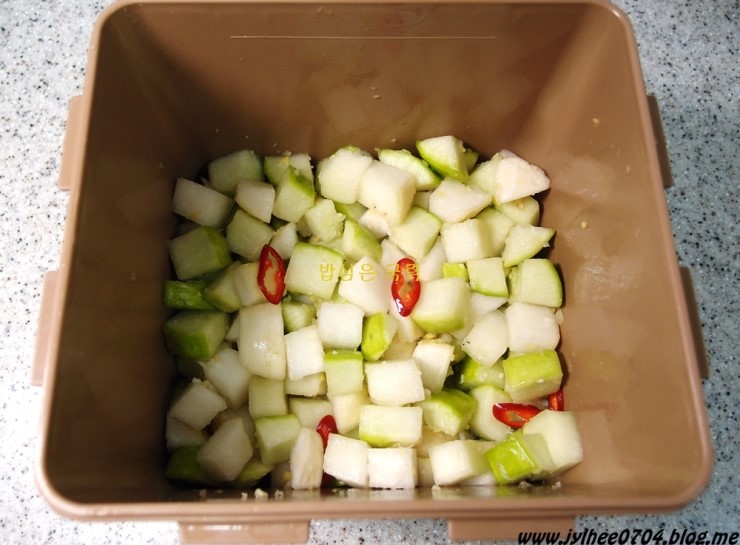 STEP 11/12Don't you feel the cool taste just by looking at it?
STEP 11/12Don't you feel the cool taste just by looking at it?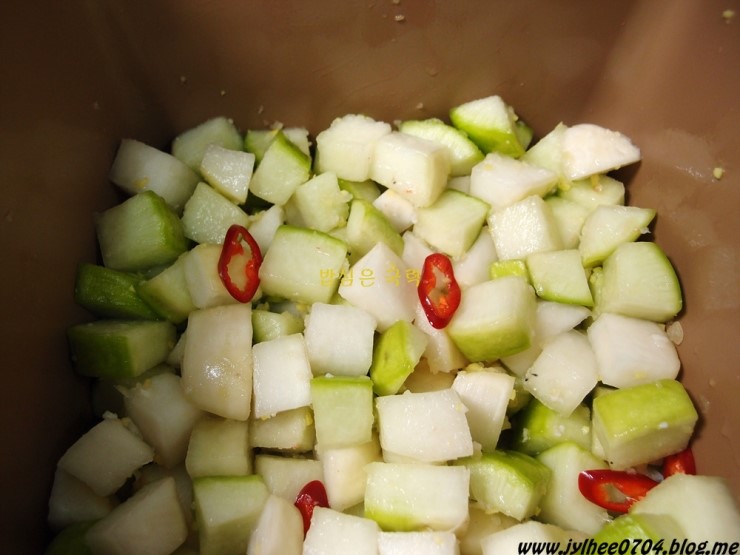 STEP 12/12Baekkkakdugi is done. It's a white radish kimchi that's been cooked for 3 days. There's also kkakdugi soup. You can see the visuals of the cooked radish kimchi, right? It is recommended for children or those who can't eat spicy food due to stomach problems. Try making Baekkkakdugi, where you can feel the cool and clean taste of radish.
STEP 12/12Baekkkakdugi is done. It's a white radish kimchi that's been cooked for 3 days. There's also kkakdugi soup. You can see the visuals of the cooked radish kimchi, right? It is recommended for children or those who can't eat spicy food due to stomach problems. Try making Baekkkakdugi, where you can feel the cool and clean taste of radish.
- chicken Recommended recipe
-
-
1
 [Crispy fried chicken] You can make homemade fried chicken at ho4.50(6)
[Crispy fried chicken] You can make homemade fried chicken at ho4.50(6) -
2
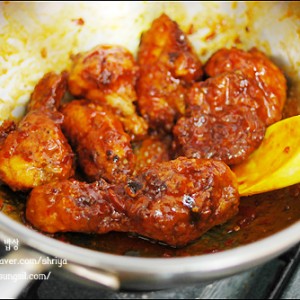 Fried and seasoned chicken4.86(7)
Fried and seasoned chicken4.86(7) -
3
 Making kkanpung chicken with leftover chicken4.88(8)
Making kkanpung chicken with leftover chicken4.88(8) -
4
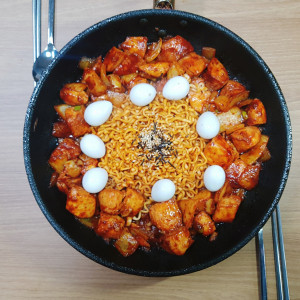 Pickled chicken. Charcoal chicken5.00(9)
Pickled chicken. Charcoal chicken5.00(9)
-
- Bulgogi Recommended recipe
-
-
1
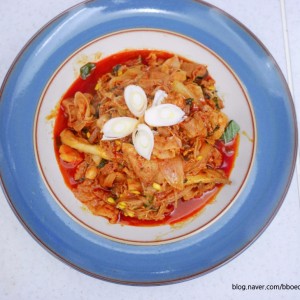 Jongwon Baek Bean sprout bulgogi golden recipe rice thief~4.89(63)
Jongwon Baek Bean sprout bulgogi golden recipe rice thief~4.89(63) -
2
 "Bean fire without failure!" Dinner menu recommendation. Making4.88(33)
"Bean fire without failure!" Dinner menu recommendation. Making4.88(33) -
3
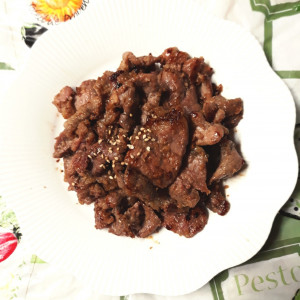 Bulgogi with pork and soy sauce4.97(29)
Bulgogi with pork and soy sauce4.97(29) -
4
 [Simple home-cooking] Request chain! Making delicious soybean pa4.97(504)
[Simple home-cooking] Request chain! Making delicious soybean pa4.97(504)
-